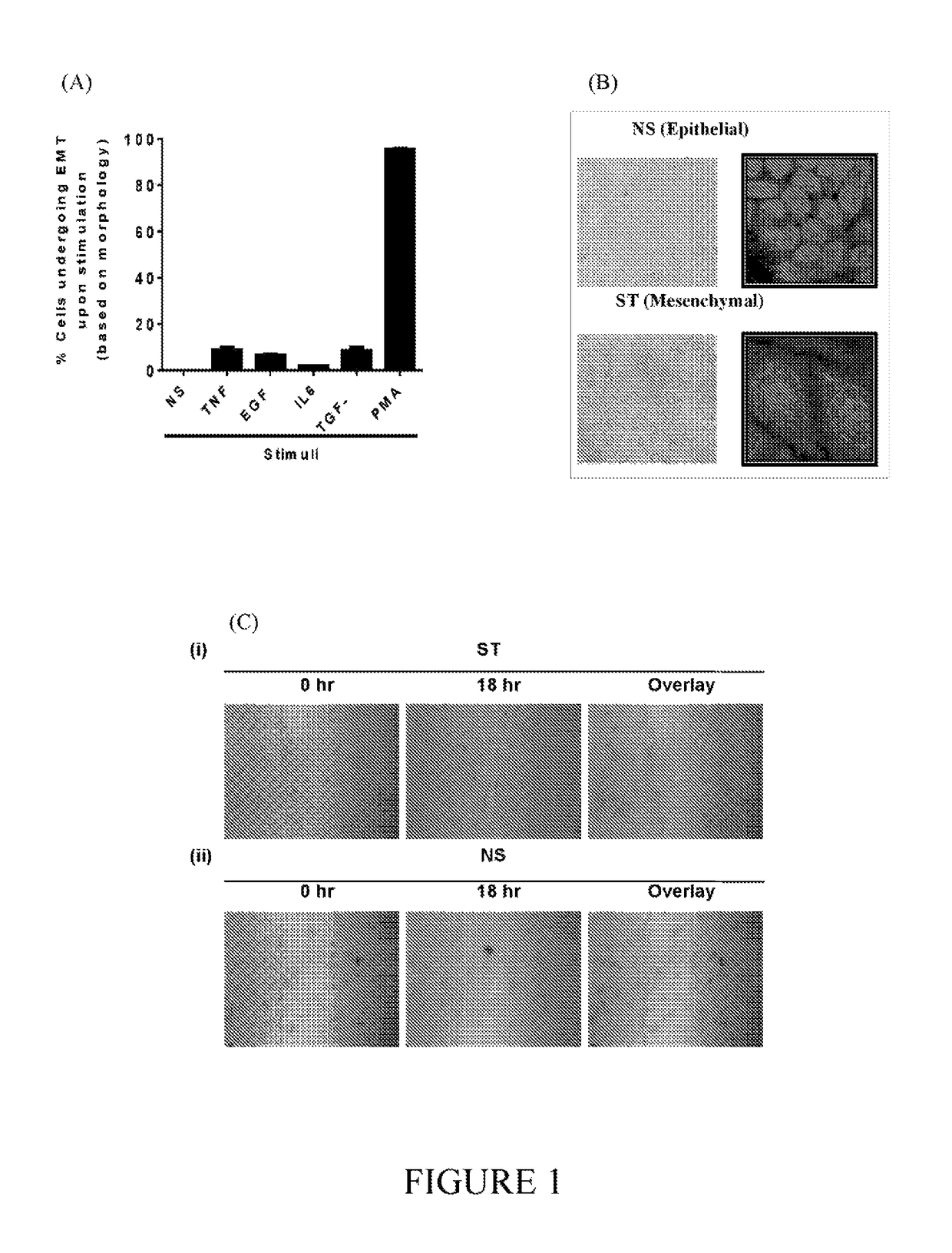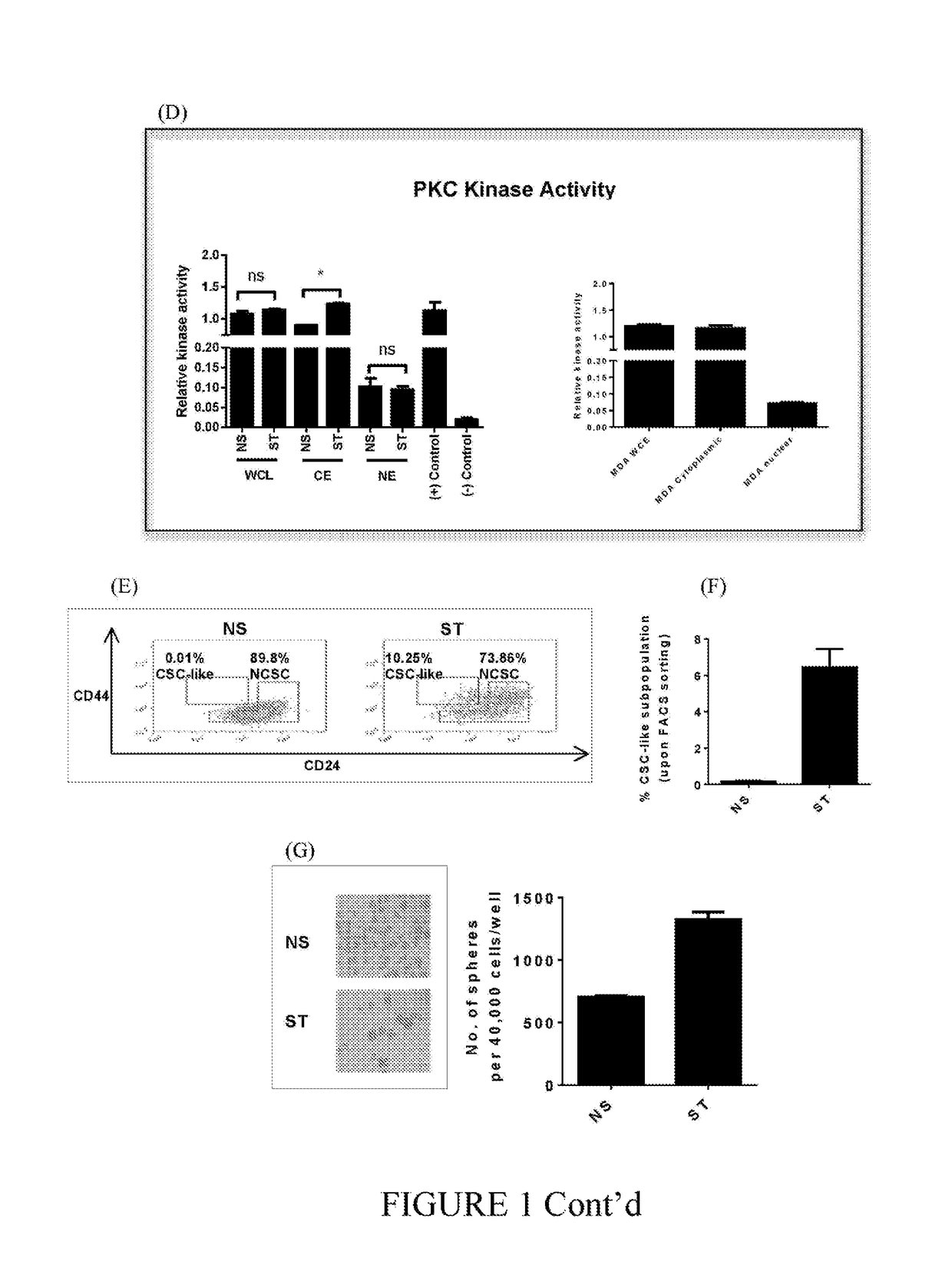Stem cell modulation II
a stem cell and stem cell technology, applied in the field of stem cell modulation ii, can solve the problems of cancer recurrence, slow cell turnover rate, and unknown potential role of csc-specific differentiation plasticity in tumorigenicity, and achieve the effects of inhibiting emt, reducing or inhibiting the proliferation of csc, and reducing cancer recurren
- Summary
- Abstract
- Description
- Claims
- Application Information
AI Technical Summary
Benefits of technology
Problems solved by technology
Method used
Image
Examples
example 1
PKC Pathway; EMT and CSC
[0622]PKC pathway is associated by EMT and CSC utilizing a variety of cellular assays. First PKC pathway inducer, PMA caused highest EMT changes as observed by morphological changes (FIGS. 1 A and B), EMT marker-Laminin-5′s intracellular staining (FIG. 1 B) and wound healing (Migration assays) (FIG. 1 C) in MCF-IM model. Second, PKC is active in both cytoplasm and nuclei in the MCF-IM and basal / metastatic model (FIG. 1 D). Third, induction of PKC pathway by PMA results in the generation of CD44high / CD24low-CSC like cells as observed by flow cytometry (FACS) analysis (FIGS. 1 E and F), mammosphere assay (FIG. 1 G) and transcript analysis of CSC-inducible genes (FIG. 1 H) and microRNAs (FIG. 1 I).
[0623]Overall these results show that PKC pathway is important for EMT and CSC formation.
example 2
Inhibition of PKC Activity Reduces EMT and CSC Formation
[0624]Broad spectrum PKC pathway inhibitor results in inhibition of EMT and CSC formation in MCF-IM model as monitored by morphology (FIG. 2 A), FACS (FIGS. 2 B & C), mammosphere assay (FIGS. 2 D & E) and transcript analysis of CSC-inducible genes (FIGS. 2 F & G) and also in basal metastatic model (FIGS. 2 I, J & K). In contrast, pre-incubation with Go6976, a conventional PKC inhibitor did not prevent PMA-induced EMT-like morphological changes or CSC formation (FIGS. 2 C & H).
[0625]Overall these results show that PKC activity is essential for EMT and CSC formation.
example 3
Inhibition of PKC-θ Signaling and Nuclear Effect Results in Abolishment of EMT and CSC
[0626]PKC-θ specific peptide inhibitor abolishes EMT and CSC as monitored by morphology (FIG. 3 A), FACS (FIG. 3 B) and transcript analysis (FIG. 3 C) in MCF-IM model. Knockdown of PKC-θ but not PKC-β results in inhibition of EMT and CSC in MCF-IM model (FIGS. 3 D, E& F). Over-expression of PKC-θ MLS (Nuclear Localization Signal) mutation reduces entry of PKC-θ in nucleus and therefore results in reduction of EMT and CSC effects in comparison to effect of PKC-θ Wild type vector in MCF-IM model (FIGS. 3 G, H and I)
[0627]Overall these results show that PKC-θ is the master-regulator of EMT and CSC formation. In addition, nuclear PKC-θ is important for EMT and CSC formation.
PUM
 Login to View More
Login to View More Abstract
Description
Claims
Application Information
 Login to View More
Login to View More - R&D
- Intellectual Property
- Life Sciences
- Materials
- Tech Scout
- Unparalleled Data Quality
- Higher Quality Content
- 60% Fewer Hallucinations
Browse by: Latest US Patents, China's latest patents, Technical Efficacy Thesaurus, Application Domain, Technology Topic, Popular Technical Reports.
© 2025 PatSnap. All rights reserved.Legal|Privacy policy|Modern Slavery Act Transparency Statement|Sitemap|About US| Contact US: help@patsnap.com



